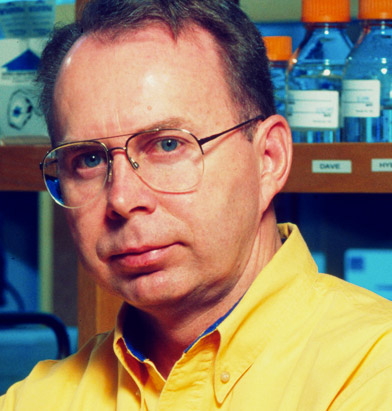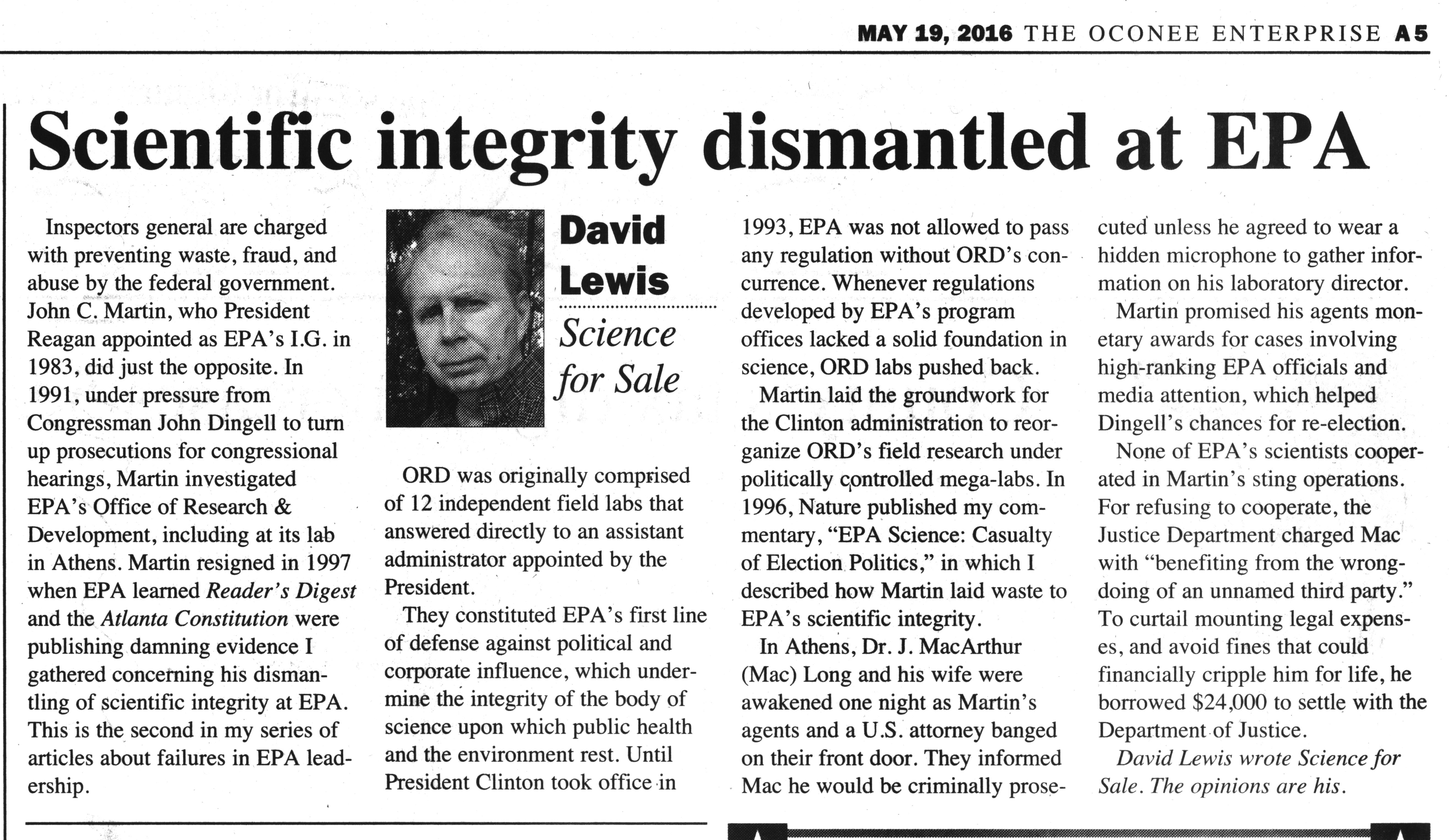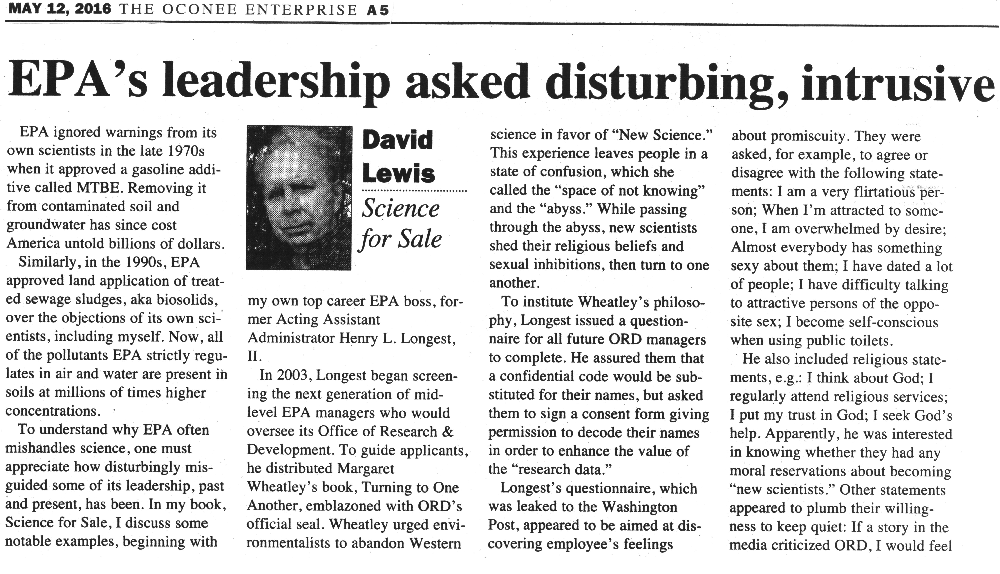-
- Congressional Testimony of EPA's Dr. David L. Lewis
- Hearing by the Committee on Resources, Subcommittee on Energy and Minerals
U.S. House of RepresentativesFebruary 4, 2004Room 1324 Longworth House Office Building
__________________
Testimony of David L. Lewis, Ph.D.
Madam Chairman and Members of the Energy and Mineral Resources Subcommittee:
Until May 2003, I worked as a GS-15 scientist at the U.S. Environmental Protection Agency's research laboratory in Athens, Georgia. I appreciate this opportunity to testify about science and public policy, and how important it is to ensure that public policy embraces free and open scientific debate.
Based on my 31 years of experience at the EPA, I can assure the Members of this Subcommittee that EPA has completely politicized the scientific peer-review process, both inside and outside the Agency. I want to bring two examples to your attention. These examples illustrate the almost unbelievable extent to which the EPA has corrupted the scientific peer-review process in order to support certain political agendas and further the Agency's self-interests.
These examples involve EPA's efforts to cover up problems with its 503 Sludge Rule - a rule that allows processed sewage sludge (biosolids) to be used for mining reclamation and similar uses within the purview of this Subcommittee. EPA promulgated the Rule in 1993 despite the fact that it failed the Agency's internal scientific peer-review process. While EPA's position is that the Rule adequately protects public health and the environment, a growing number of workers handling sludge and residents living near land application sites are reporting illnesses and deaths of humans and animals.
On December 24, 2003, the Assistant Administrator of EPA's Office of Water issued a Decision dismissing any linkage between exposure to sewage sludge and adverse health effects. My testimony will show that the Assistant Administrator:
Chose not to acknowledge the existence of peer-reviewed research in leading scientific and medical journals supporting such a linkage.
Relied on information from an anonymous, non-peer-reviewed white paper - which the EPA Inspector General had recommended one EPA employee be disciplined for distributing
Used data that the EPA knew the State of Georgia had found to be unreliable, possibly even fraudulent - and which the EPA had funded university researchers to publish in a peer-reviewed journal knowing that the data were unreliable
As part of my official EPA duties from 1996-2003, I researched the growing number of anecdotal reports alleging illnesses and deaths from exposure to sewage sludge applied under EPA's guidance. To do this, I surveyed the affected individuals, obtained their medical records, collaborated with some of their treating physicians, gathered local government records on land application, and analyzed environmental samples and other relevant information. An overview of these studies is published in a peer-reviewed Research Commentary in the current issue of the National Institutes of Health journal, Environmental Health Perspectives.
[http://ehp.niehs.nih.gov/docs/2004/112-2/toc.html]
EPA Bisoludge Study by Dr. David Lewis 2004
Inspector General dismantled scientific integrity at EPA
The Oconee Enterprise, May 19, 2016:
Dr. David Lewis
Inspectors General are charged with preventing waste, fraud, and abuse by the federal government. John C. Martin, who President Reagan appointed as EPA’s IG in 1983, did just the opposite. In 1991, under pressure from Congressman John Dingell to turn up prosecutions for congressional hearings, Martin investigated EPA’s Office of Research & Development (ORD), including at its lab in Athens, Georgia. Martin resigned in 1997 when EPA learned Reader’s Digest and the Atlanta Constitution were publishing damning evidence I gathered concerning his dismantling of scientific integrity at EPA. This is the second in my series of articles about failures in EPA leadership.

EPA’s disturbing leadership – Dr. David Lewis
Click to read Dr. Lewis’ first article on on EPA Leadership | EPA ignored warnings from its own scientists in the late 1970s when it approved a . . .
ORD was originally comprised of twelve independent field labs that answered directly to an Assistant Administrator appointed by the President. They constituted EPA’s first line of defense against political and corporate influence, which undermine the integrity of the body of science upon which public health and the environment rest. Until President Clinton took office in 1993, EPA was not allowed to pass any regulation without ORD’s concurrence. Whenever regulations developed by EPA’s program offices lacked a solid foundation in science, ORD labs pushed back.
Martin laid the groundwork for the Clinton administration to reorganize ORD’s field research under politically controlled mega-labs. In 1996, Nature published my commentary, “EPA Science: Casualty of Election Politics,” in which I described how Martin laid waste to EPA’s scientific integrity. I wrote:
“Allegations of mismanagement abounded as the director of the EPA’s research laboratory in Duluth, Minnesota, the first of several laboratories to be investigated, was fired and other managers and scientists were either dismissed or sent on leave without pay. They were, however, reinstated by federal judges, who ruled that the agency’s allegations were without merit and that investigations had been carried out in bad faith.”
In Athens, Dr. J. MacArthur (Mac) Long and his wife were awakened one night as Martin’s agents and a U.S. Attorney banged on their front door. They informed Mac he would be criminally prosecuted unless he agreed to wear a hidden microphone to gather information on his laboratory director. Martin promised his agents monetary awards for cases involving high-ranking EPA officials and media attention, which helped Dingell’s chances for re-election.
The Georgia Bureau of Investigation, which assisted EPA’s Office of Inspector General, wanted Mac to question his director outside the building. It promised to have agents hiding in the shrubbery, ready to spring into action if she smelled a rat and tried to physically harm him. None of EPA’s scientists cooperated in Martin’s sting operations. For refusing to cooperate, the Justice Department charged Mac with “benefiting from the wrongdoing of an unnamed third party.” To curtail mounting legal expenses, and avoid fines that could financially cripple him for life, he borrowed $24,000 to settle with the Department of Justice.
Dr. Lewis’ article posted in The Oconee Enterprise – Click to enlarge

David Lewis, Ph.D.
Former U.S. EPA Research Microbiologist
David Lewis is an internationally recognized research microbiologist whose work on public health and environmental issues, as a senior-level Research Microbiologist in EPA’s Office of Research & Development and member of the Graduate Faculty of the University of Georgia, has been reported in numerous news articles and documentaries from TIME magazine and Reader’s Digest to National Geographic.
Supreme Court drives federal research misconduct
The Oconee Enterprise, January 12, 2017:
Dr. David Lewis
In 1993, the U.S. Supreme Court ruled in Daubert v. Merrell Dow Pharmaceuticals that the admissibility of expert witness testimony rests upon the scientific literature. Whichever side carries the greatest weight in terms of peer-reviewed scientific articles wins. While scientists are required to acknowledge financial conflicts of interest with commercial entities that may profit from their research, no comparable requirements exist for government-funded scientists who publish data supporting government policies, guidelines and regulations.
As a case in point, Michael Cook at EPA headquarters in Washington, DC, amended a cooperative agreement with an industry trade association in 1996 so EPA could give grants to land grant universities to publish research supporting EPA’s 503 rule. The rule allows municipalities to spread tons of treated sewage sludges, a.k.a. biosolids, on school playgrounds, farms and other public and private lands—without limiting levels of toxic chemicals and most heavy metals in industrial wastes contained in the material.
EPA’s disturbing leadership
The Oconee Enterprise, May 12, 2016:
Dr. David Lewis
EPA ignored warnings from its own scientists in the late 1970s when it approved a gasoline additive called MTBE. Removing it from contaminated soil and groundwater has since cost America untold billions of dollars. Similarly, in the 1990s, EPA approved land application of treated sewage sludges, a.k.a. biosolids, over the objections of its own scientists, including myself. Now, all of the pollutants EPA strictly regulates in air and water are present in soils at millions of times higher concentrations.
To understand why EPA often mishandles science, one must appreciate how disturbingly misguided some of its leadership, past and present, has been. In my book, Science for Sale, I discuss some notable examples, beginning with my own top career EPA boss, former Acting Assistant Administrator Henry L. Longest, II.
Dr. Lewis’ article posted in The Oconee Enterprise – Click to enlarge
In 2003, Longest began screening the next generation of mid-level EPA managers who would oversee its Office of Research & Development (ORD). To guide applicants, he distributed Margaret Wheatley’s book, Turning to One Another, emblazoned with ORD’s official seal. Wheatley urged environmentalists to abandon Western science in favor of “New Science.” This experience leaves people in a state of confusion, which she called the “space of not knowing” and the “abyss.” While passing through the abyss, new scientists shed their religious beliefs and sexual inhibitions, then turn to one another.
To institute Wheatley’s philosophy, Longest issued a questionnaire for all future ORD managers to complete. He assured them that a confidential code would be substituted for their names, but asked them to sign a consent form giving permission to decode their names in order to enhance the value of the “research data.”
Longest’s questionnaire, which was leaked to the Washington Post, appeared to be aimed at discovering employees’ feelings about promiscuity. They were asked, for example, to agree or disagree with the following statements: I am a very flirtatious person; When I’m attracted to someone, I am overwhelmed by desire; Almost everybody has something sexy about them; I have dated a lot of people; I have difficulty talking to attractive persons of the opposite sex; I become self-conscious when using public toilets.
He also included religious statements, e.g.: I think about God; I regularly attend religious services; I put my trust in God; I seek God’s help. Apparently, he was interested in knowing whether they had any moral reservations about becoming “new scientists.” Other statements appeared to plumb their willingness to keep quiet: If a story in the media criticized ORD, I would feel embarrassed; and I’m always respectful of people of higher status than myself.
Longest was known throughout EPA for demeaning women. Although formal complaints were filed, this behavior never stopped. Over his long career, he received EPA’s highest honors, including two Presidential awards in Rose Garden ceremonies at the White House.
Sewage sludge
 |
WARNING! Sewage sludge is toxic. Food should not be grown in "biosolids." Join the Food Rights Network. |
 |
This article is part of the Food Rights Network, a project of the Center for Media and Democracy. Find out more here. |
Sewage sludge is the growing and continuous mountain of hazardous waste produced daily by city sewage plants. The sewage sludge industry has created a PR euphemism it uses in place of the words 'sewage sludge': biosolids. There is now a SourceWatch Portal on Toxic Sludge The sewage sludge industry promotes its product through front groups and stakeholders including Water Environment Federation, US Composting Council, BioCycle magazine, and others.
What is Sewage Sludge?
A list of just some of the hazardous chemicals and pathogens found in sludge can be found in the article Sludge contaminants. Sludge contaminants include Dioxins and Furans, Flame Retardants, Metals, Organochlorine Pesticides, 1,2-Dibromo-3-Chloropropane (DBCP), Naphthalene, Triclosan, Nonylphenols, Phthalates, Nanosilver, and thousands more substances.
- "Sewage is the mix of water and whatever wastes from domestic and industrial life are flushed into the sewer. To retrieve the precious water, the sewage is then 'treated,' that is, 'cleaned,' in what are called 'treatment plants.' The ideal of the treatment plant is to take out of the sewer water all the 'wastes' that sewering put into it. The water is 'cleaned' in the degree to which the pollutants which had turned the water into sewage are removed by treatment-primary, secondary, or tertiary-and concentrated in the sludge. We must note that, though the aim of sewage treatment is to produce clean water, it is never to produce 'clean' sludge. Indeed, the 'dirtier' the sludge - the more complete its concentration of the noxious wastes - the more the treatment has done its job. If there are industrial chemicals, pharmaceuticals, hormones, nano particles, prions, hospital wastes including antibiotic-resistant bacteria - and there will be all of these - you want them to end up in the sludge. Every waste produced in our society that can be got rid of down toilets and drains and that can also be got out of the sewage by a given treatment process will be in the sludge. Sludge is thus inevitably a noxious brew of vastly various and incompatible materials unpredictable in themselves and in the toxicity of their amalgamation, incalculably but certainly wildly dangerous to life." [1]
Why is Toxic Sewage Sludge Dumped on Farm and Gardens?
"The policy of disposing of sludge by spreading it on agricultural land - a policy given the benign term 'land application' - has its inception in the Ocean Dumping ban of 1987. Before 1992, when the law went into effect, the practice had been, after extracting the sludge from the wastewater, to load it on barges and dump it 12, and later 106 miles off shore into the ocean. But many people who cared about life in the ocean knew that, wherever it was dumped, the sludge was causing vast dead moon-scapes on the ocean floor. New EPA regulations for 'land application' were promulgated in 1993. With the aid of heating and pelletizing and some slippery name morphs along the way, EPA claimed sludge could be transmogrified into 'compost' ... . But the land “application” of sewage sludge ... will pollute the whole chain of life for which soil is the base." [2] In 2002, the National Research Council found that the "U.S. Environmental Protection Agency's standards that govern using treated sewage sludge on soil are based on outdated science."[3] This was again confirmed in 2011 when scientists found that noroviruses survive treatment that kills pathogens such as Salmonella.[4]
In March 2013, a study involving neighbors of land where sewage sludge had been dumped -- "living in rural and semirural areas within approximately one mile of sewage sludge land application sites in North Carolina, South Carolina and Virginia" -- found that "over half of respondents attributed physical symptoms to application events." More specifically, "Over half (18/34) of the interview respondents associated acute physical symptoms that lasted a short period of time with sludge application events near their home (Table 1). The most commonly reported symptoms were eye, nose, and throat irritations and gastrointestinal symptoms (nausea, vomiting, diarrhea). Other symptoms reported by more than one respondent include cough, difficulty breathing, sinus congestion or drainage, and skin infections or sores."[5]
Multiple System Atrophy Overview
Multiple system atrophy, or MSA, is a rare, degenerative neurologic condition that affects both men and women, usually starting in the 50’s or early 60’s1. MSA is considered a type of parkinsonism but with more widespread effects on the brain and body. The condition was first identified in 1962 and named Shy-Drager syndrome for two physicians who reported patients showing a combination of Parkinson-like movement disorders and problems with the autonomic, or body-regulating division of the nervous system2.




